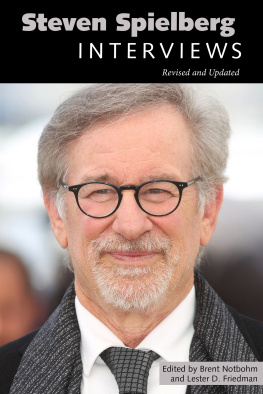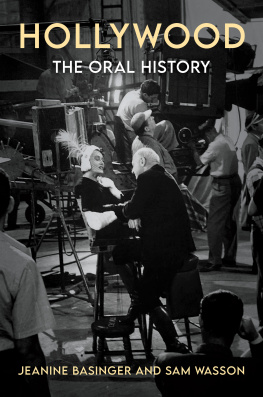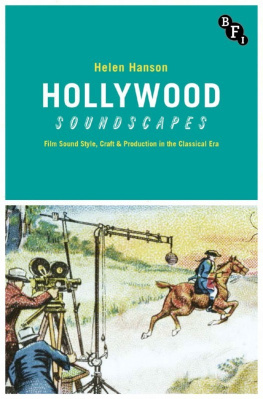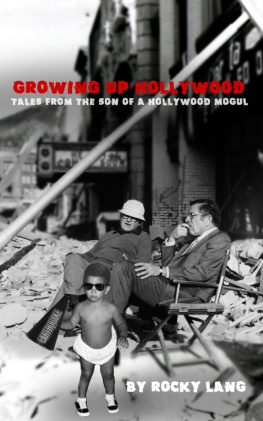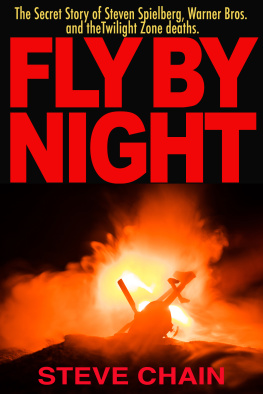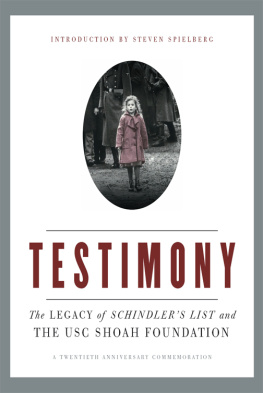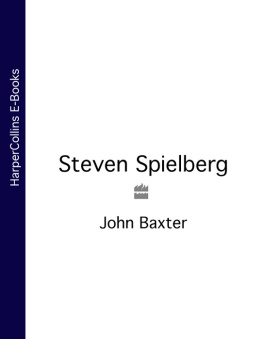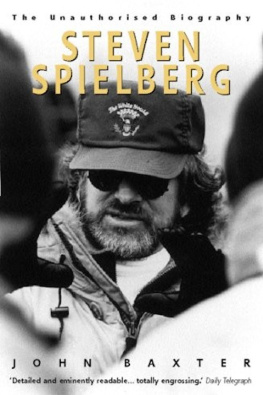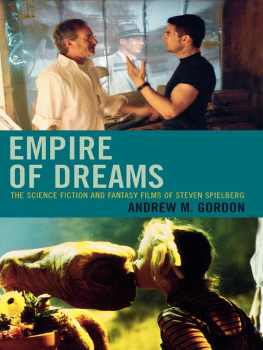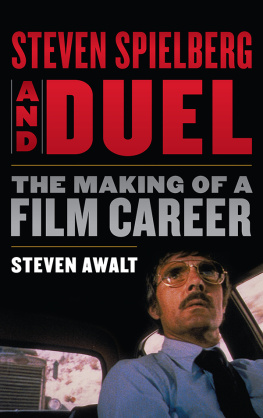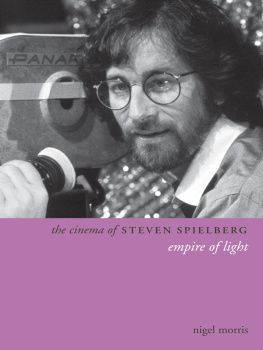1. Introduction: Setting the Scene
Now well into his fifth decade as a film director, Steven Spielberg has established himself as the worlds most popular and financially successful feature filmmaker and various box office statistics illustrate this dominance. Six of the films he has directed feature in the all-time top 100 box office revenue list including two in the top ten (Box Office Mojo ).
Published at the end of the 1970s, Michael Pye and Lynda Myles The Movie Brats identified six directorsFrancis Coppola , Martin Scorsese , George Lucas , Brian De Palma , John Milius and Spielbergand characterised them as the new heirs to Hollywood. The label arose from their collective youth, box office successes and high degree of cine-literacy. The authors also suggested that these six were pure filmmakers, from film schools (except Spielberg) and not sullied by a previous career in television like many of the other directors working in Hollywood at the time., pp. 914).
Spielbergs early popularity was so spectacular that it has evolved into almost mythical status. With Jaws (1975), Spielberg is widely perceived to have initiated the blockbuster phenomenon that now dominates the American industry (Shone , p. 42) notes that this kind of saturation booking had actually been applied since the 1940s on stiffs, films that were expected to perform poorly and so were quickly given wide release to recoup as much revenue as possible before word-of-mouth and poor reviews compromised admissions.
Further colouring the perception of the movie brats and Spielberg as all-conquering, Peter Kramer () notes some inconsistency over which period New Hollywood actually represents:
in different critical contexts New Hollywood may refer to the period 196775 as well as to the post-1975 period, to the aesthetic and political progressivism of the liberal cycles of the earlier period as well as to the regressiveness of the blockbusters of the later period. (p. 303)
He also queries the newness of the New Hollywood era by pointing out that juvenilzation, the role of technology in enhancing cinematic presentation, and the emphasising of spectacle over narrative had all been going on since the 1950s and were as such part of a longer term cycle that predated the 1970s revival. Geoff King (, p. 257) adds that the conditions that enabled the rise of the New Hollywood as a phenomenon had begun with the decline of the audience from the mid-1940s, the theatre-antitrust action, the multiple box-office failures of expensive films in the mid-1960s and the passing of the studio moguls.
Yet there is no denying that as each of his contemporaries has fallen by the wayside, Spielbergs critical esteem, power and influence within the film industry have continued to grow. Of the original movie brats , only Scorsese and Spielberg are still releasing features regularly. Despite the enormous impact of the Star Wars films on popular culture, Lucas has directed only six features and in 2013 announced his retirement from directing. Other contemporaries who enjoyed popular success during the 1970s such as Peter Bogdanovich (his recent work is mostly in television ) and William Friedkin (he has directed two features in the past ten years) failed to preserve their popular success beyond that decade. Even Robert Zemeckis considered a Spielberg protg and the nearest rival in all-time box office earningshas failed to sustain the popularity he enjoyed with a string of box office hits during the 1980s and 1990s. Though not considered part of the mainstream industry, only Woody Allen surpasses Spielberg in terms of volume as a director, managing to consistently release a low-budget feature almost every year since the 1970s.
If we go beyond Spielbergs work as a director and consider all of the film industry production in which he has had some kind of involvement, his output can only be described as prolific. In addition to the 30
Not only does Spielberg clearly know how to direct films that almost always attract a wide audience, he has managed to do so consistently for more than 40 yearsa sustained period of popular success unmatched in Hollywood. In terms of combining success and longevity, John Ford likely comes the closest with a career that spanned six decades and some 130 films though he never really achieved the spectacular box office with individual films in the way that Spielberg has. Similarly, a number of other directors including Alfred Hitchcock (53 features over six decades) and Howard Hawks (40 features over four decades) enjoyed long careers that included extended periods of popularity and success.
Following on from the uncertainty and multiple box-office failures of the late 1960s, Cook () proposes an even broader, more generalised sense of genre :
genre and generic are multifaceted concepts and terms: if genre can mean category, generic can mean constructed or marked for commercial consumption; If genre can mean corpus, generic can mean conventionally comprehensible; if genre can mean formula, generic can mean those aspects of representation that entail the generation of expectations; and so on. (p. 252)
The genre film proved less risky for studios and could be more easily packaged, promoted and marketed worldwide. Genre film provided an audience with an immediately recognisable experience and clear differentiation between types of films, a condition most clearly realised in the related rise of the sequel, remakes and the movie series (Neale
Carroll ( and the connoisseur viewer, knowledgeable of the embedded references to other films or contexts. Carroll has labelled this concept of an awareness of cinema, of a cine-literacy as allusionism .
an umbrella term covering a mixed lot of practices including quotations, the memorialization of past genres , the reworking of past genres , homages, and the recreation of classic scenes, shots , plot motifs, lines of dialogue, themes gestures, and so forth from film history, especially as that history was crystallized and codified in the sixties and early seventies. (p. 241)
Allusionism was central to the relationship between the movie brat directors, the films they were making and audiences. As the term movie brats implies and like their audiences, all of these directors where young in the 1970sall under 30 at the time of their first feature with Spielberg the youngest at 25 for The Sugarland Express and still under 30 at the release of Jaws . Also important was the role played by television in exposing both the emerging filmmakers and audiences to the history of Hollywood cinema.
televisions archiving of classical cinema by constantly recycling studio-era film helped to form the new Hollywood historical consciousnessthat unique sense of retrospection that informs the work of nearly every major figure of the 70s from Altman through Spielbergbecoming a major part of demarcation between the old Hollywood and the new. (Cook , p. 173)
As with many of the American 1960s auteur directors that were heavily influenced by the influx of European art-cinema occurring around the same time,, p. 12). This suggests a further correlation between the types of films he was making in the 1970s and the audiences for them. Spielbergs popular success continued into the 1980s with Raiders of the Lost Ark (1981) and E.T. (1982), still his most successful film. With the exception of two Raiders sequels the remainder of the 1980s proved to be a lean period by Spielberg standards. This changed in 1993 with the critical and commercial success of Schindlers List (1993) and the enormous popularity of Jurassic Park (1993). The 1990s continued to be a successful decade with a popular Jurassic Park sequel in 1997 and a second Academy Award for the popular Saving Private Ryan (1998). The 2000s also saw a number of strong performers at the box office with Minority Report (2002), Catch Me if You Can (2002), War of the Worlds (2005) and another Raiders sequel in 2008.


